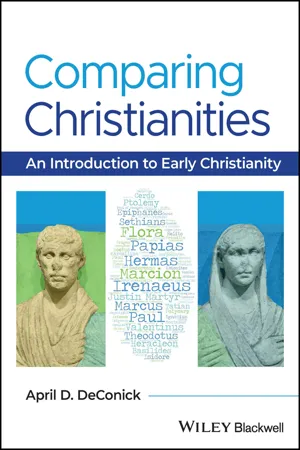
- English
- ePUB (mobile friendly)
- Available on iOS & Android
About this book
A ground-breaking introductory textbook for the study of the New Testament and the first Christians, written for the next generation of students
Comparing Christianities: An Introduction to the New Testament and the First Christians maps the historical rise of Christianity out of a network of early Christian movements. This major new textbook systematically explores the struggles to define the faith by presenting Christianity as the result of a lengthy process of religious consolidation which emerged from a landscape of persistent Christian diversity.
The book delves into the history of the first five generations of Christians, from Paul to Origen. The first chapter considers the challenges of constructing Christian histories and offers a new model of Christian families to organize and explain the emergence and competition of different varieties of Christianity. Each successive chapter focuses on key issues that Christian leaders engaged over the centuries, demonstrating how the questions they posed and the answers they provided gave Christianity its distinct shape. As the movements competed for social advantage, Christians began identifying certain Christian movements as enemies and consolidated against them. The final chapter schematizes the Christians studied in the book into three families of Christian movements based on the particular God they worshipped and other shared patterns of thought and practice. This chapter also explains where the varieties of Christianities came from and how the process of consolidation undertaken by some churches shaped Christian identity within a forge of intolerance that still affects us today.
Comparing Christianities explores the answers to questions:
- Who were the early Christians and what did they write?
- What did Christians think about sex, women, immortality, Judaism, suffering and death?
- What rituals did the first Christians practice, and what did their religious experiences mean to them?
- How did Christians live in a Roman-dominated world?
- How did the first Christians explain the origins of their movement?
Comparing Christianities: An Introduction to the New Testament and the First Christians serves as an excellent primary textbook in undergraduate classrooms for Introduction to Christianity, Introduction to Religion, New Testament Studies, Christian Origins, World Religions, and Western World Religions, and a thought-provoking resource for anyone wishing to know more about Christianity.
Frequently asked questions
- Essential is ideal for learners and professionals who enjoy exploring a wide range of subjects. Access the Essential Library with 800,000+ trusted titles and best-sellers across business, personal growth, and the humanities. Includes unlimited reading time and Standard Read Aloud voice.
- Complete: Perfect for advanced learners and researchers needing full, unrestricted access. Unlock 1.4M+ books across hundreds of subjects, including academic and specialized titles. The Complete Plan also includes advanced features like Premium Read Aloud and Research Assistant.
Please note we cannot support devices running on iOS 13 and Android 7 or earlier. Learn more about using the app.
Information
Table of contents
- Cover
- Title Page
- Copyright Page
- Dedication
- Table of Contents
- PREFACE
- ACKNOWLEDGMENTS
- 1 Sectarian Jews
- 2 A New Religion
- 3 Early Gnostic Churches
- 4 The Church of the Martyrs
- 5 Early Christian Philosophical Movements
- 6 The Universal Church
- 7 Holiness Movements in Asia and Syria
- 8 The Expansion of Gnostic Churches
- 9 The Construction of Orthodoxy
- 10 Church Reform
- 11 The Mystical Church
- 12 A Family History
- GLOSSARY OF TERMS
- Index
- End User License Agreement